Accounts 506: Comprehensive Financial Statement Analysis Report
VerifiedAdded on 2024/05/29
|11
|1618
|265
Report
AI Summary
This report presents a comprehensive financial analysis for Accounts 506, including adjustment entries, closing entries, and an adjusted trial balance. It features an income statement, statement of retained earnings, balance sheet, and common-size comparative balance sheet. Ratio analysis, including net profit ratio, return on assets, and return on equity, is performed to assess the company's financial health. The report also discusses strategies to improve the financial position, such as depreciation methods and inventory valuation, and addresses organizational structure and economic factors affecting the business. Desklib offers a wide range of solved assignments and past papers to aid students in their studies.
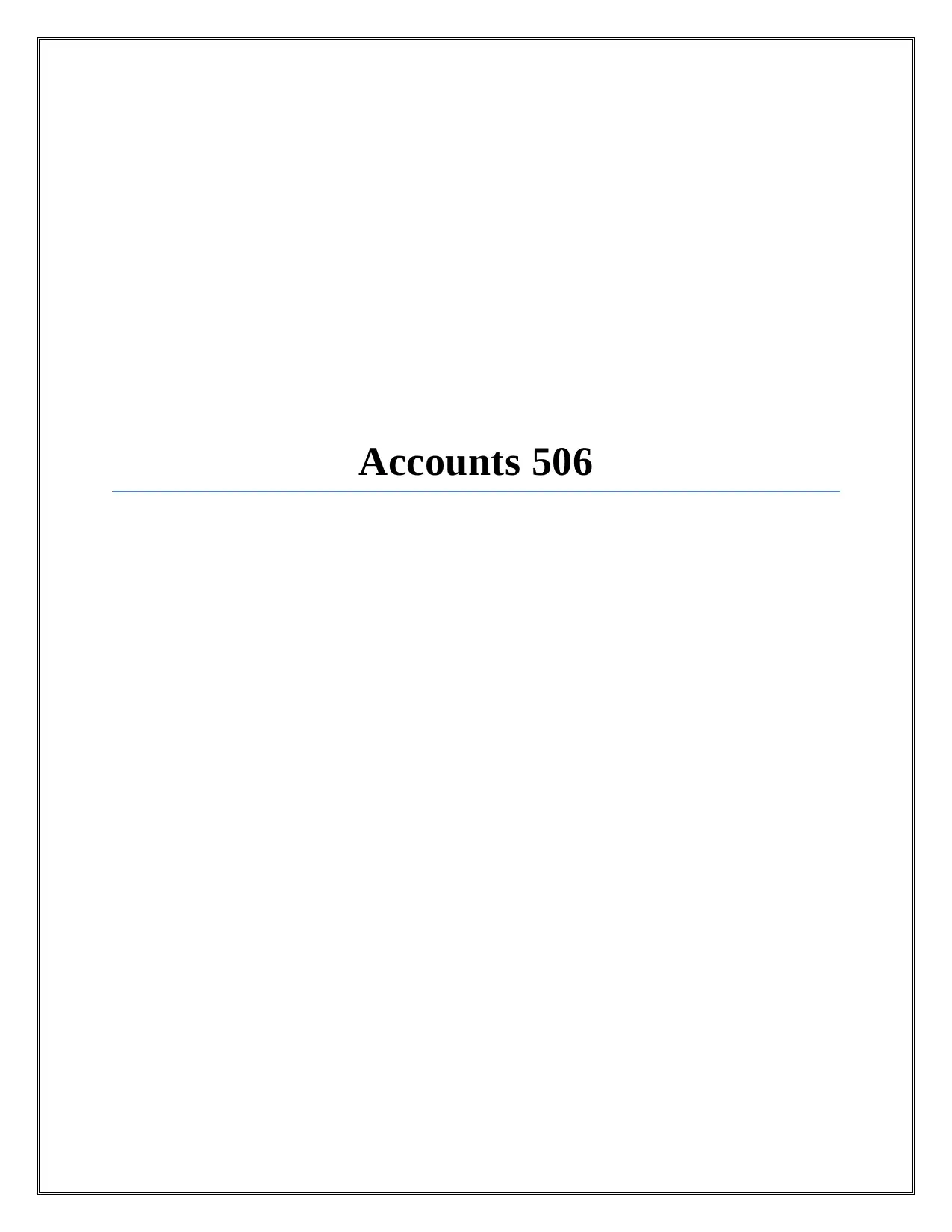
Accounts 506
Paraphrase This Document
Need a fresh take? Get an instant paraphrase of this document with our AI Paraphraser
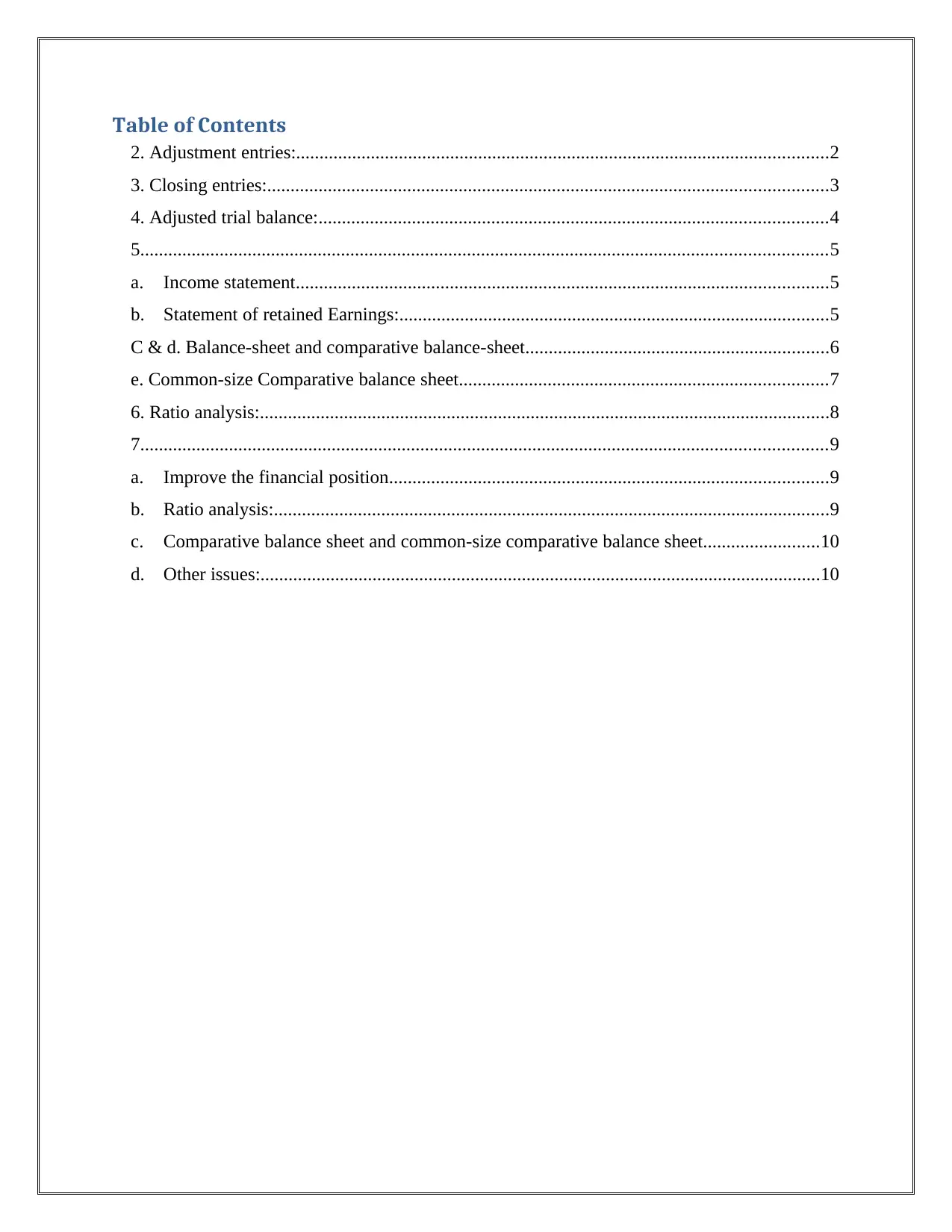
Table of Contents
2. Adjustment entries:..................................................................................................................2
3. Closing entries:........................................................................................................................3
4. Adjusted trial balance:.............................................................................................................4
5...................................................................................................................................................5
a. Income statement..................................................................................................................5
b. Statement of retained Earnings:............................................................................................5
C & d. Balance-sheet and comparative balance-sheet.................................................................6
e. Common-size Comparative balance sheet...............................................................................7
6. Ratio analysis:..........................................................................................................................8
7...................................................................................................................................................9
a. Improve the financial position..............................................................................................9
b. Ratio analysis:.......................................................................................................................9
c. Comparative balance sheet and common-size comparative balance sheet.........................10
d. Other issues:........................................................................................................................10
2. Adjustment entries:..................................................................................................................2
3. Closing entries:........................................................................................................................3
4. Adjusted trial balance:.............................................................................................................4
5...................................................................................................................................................5
a. Income statement..................................................................................................................5
b. Statement of retained Earnings:............................................................................................5
C & d. Balance-sheet and comparative balance-sheet.................................................................6
e. Common-size Comparative balance sheet...............................................................................7
6. Ratio analysis:..........................................................................................................................8
7...................................................................................................................................................9
a. Improve the financial position..............................................................................................9
b. Ratio analysis:.......................................................................................................................9
c. Comparative balance sheet and common-size comparative balance sheet.........................10
d. Other issues:........................................................................................................................10
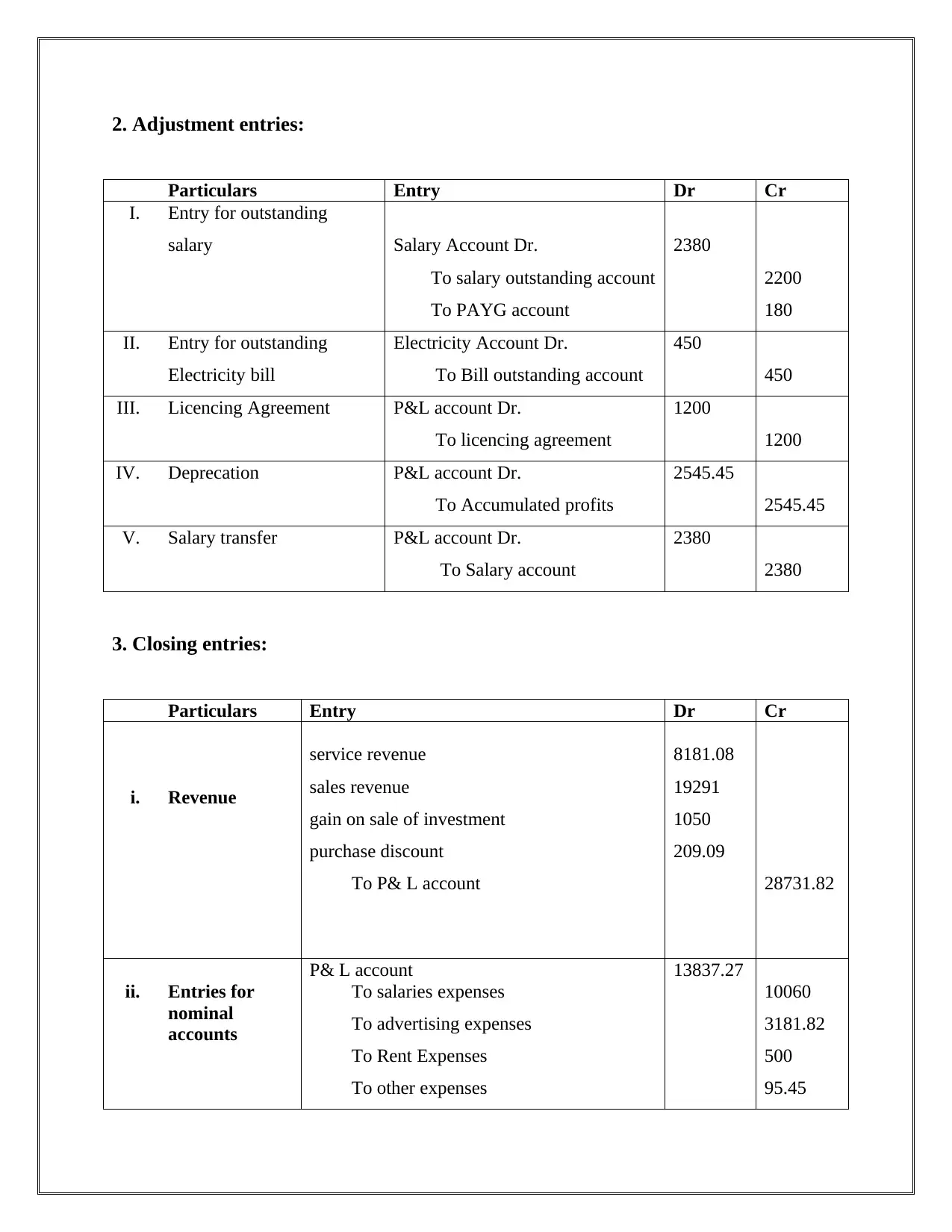
2. Adjustment entries:
Particulars Entry Dr Cr
I. Entry for outstanding
salary Salary Account Dr.
To salary outstanding account
To PAYG account
2380
2200
180
II. Entry for outstanding
Electricity bill
Electricity Account Dr.
To Bill outstanding account
450
450
III. Licencing Agreement P&L account Dr.
To licencing agreement
1200
1200
IV. Deprecation P&L account Dr.
To Accumulated profits
2545.45
2545.45
V. Salary transfer P&L account Dr.
To Salary account
2380
2380
3. Closing entries:
Particulars Entry Dr Cr
i. Revenue
service revenue
sales revenue
gain on sale of investment
purchase discount
To P& L account
8181.08
19291
1050
209.09
28731.82
ii. Entries for
nominal
accounts
P& L account
To salaries expenses
To advertising expenses
To Rent Expenses
To other expenses
13837.27
10060
3181.82
500
95.45
Particulars Entry Dr Cr
I. Entry for outstanding
salary Salary Account Dr.
To salary outstanding account
To PAYG account
2380
2200
180
II. Entry for outstanding
Electricity bill
Electricity Account Dr.
To Bill outstanding account
450
450
III. Licencing Agreement P&L account Dr.
To licencing agreement
1200
1200
IV. Deprecation P&L account Dr.
To Accumulated profits
2545.45
2545.45
V. Salary transfer P&L account Dr.
To Salary account
2380
2380
3. Closing entries:
Particulars Entry Dr Cr
i. Revenue
service revenue
sales revenue
gain on sale of investment
purchase discount
To P& L account
8181.08
19291
1050
209.09
28731.82
ii. Entries for
nominal
accounts
P& L account
To salaries expenses
To advertising expenses
To Rent Expenses
To other expenses
13837.27
10060
3181.82
500
95.45
⊘ This is a preview!⊘
Do you want full access?
Subscribe today to unlock all pages.

Trusted by 1+ million students worldwide
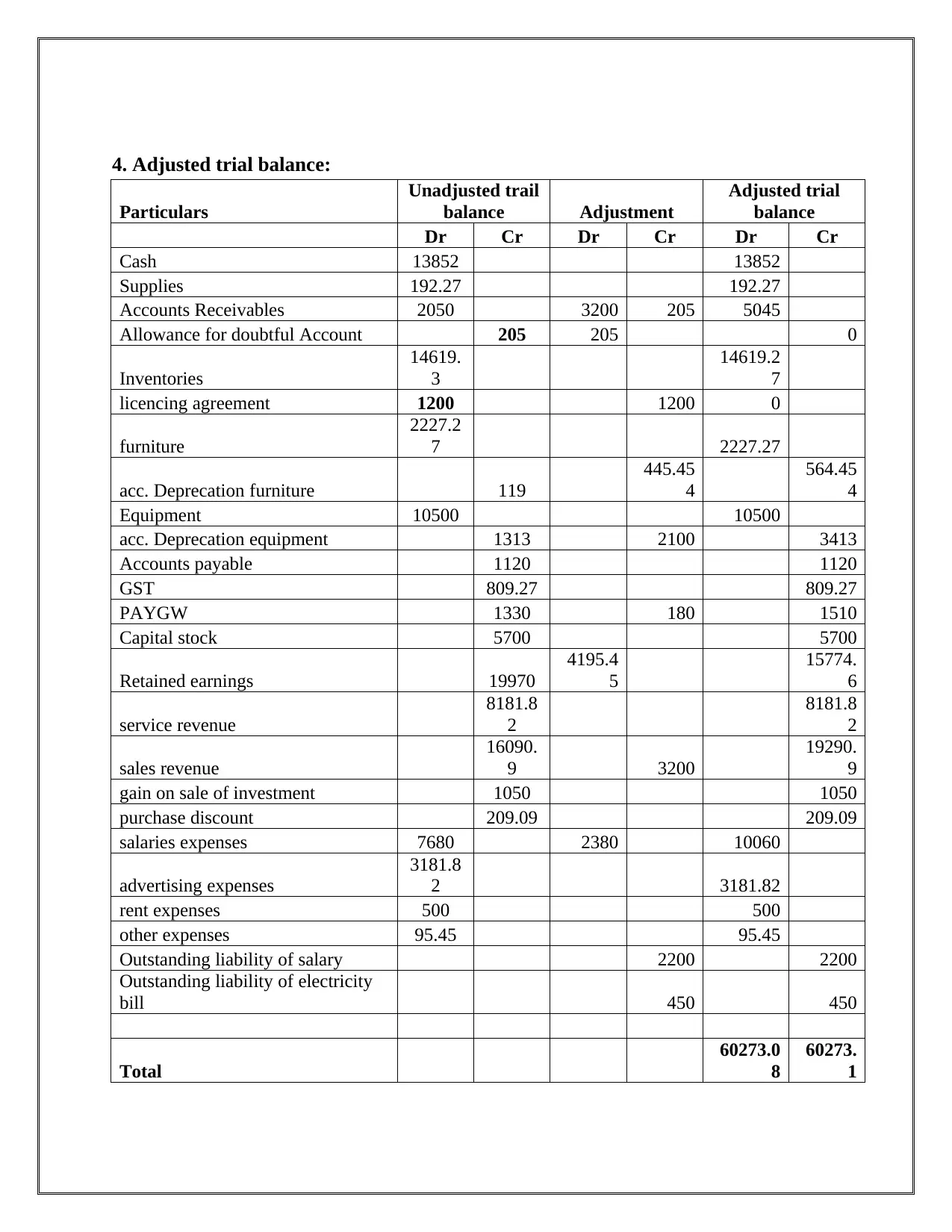
4. Adjusted trial balance:
Particulars
Unadjusted trail
balance Adjustment
Adjusted trial
balance
Dr Cr Dr Cr Dr Cr
Cash 13852 13852
Supplies 192.27 192.27
Accounts Receivables 2050 3200 205 5045
Allowance for doubtful Account 205 205 0
Inventories
14619.
3
14619.2
7
licencing agreement 1200 1200 0
furniture
2227.2
7 2227.27
acc. Deprecation furniture 119
445.45
4
564.45
4
Equipment 10500 10500
acc. Deprecation equipment 1313 2100 3413
Accounts payable 1120 1120
GST 809.27 809.27
PAYGW 1330 180 1510
Capital stock 5700 5700
Retained earnings 19970
4195.4
5
15774.
6
service revenue
8181.8
2
8181.8
2
sales revenue
16090.
9 3200
19290.
9
gain on sale of investment 1050 1050
purchase discount 209.09 209.09
salaries expenses 7680 2380 10060
advertising expenses
3181.8
2 3181.82
rent expenses 500 500
other expenses 95.45 95.45
Outstanding liability of salary 2200 2200
Outstanding liability of electricity
bill 450 450
Total
60273.0
8
60273.
1
Particulars
Unadjusted trail
balance Adjustment
Adjusted trial
balance
Dr Cr Dr Cr Dr Cr
Cash 13852 13852
Supplies 192.27 192.27
Accounts Receivables 2050 3200 205 5045
Allowance for doubtful Account 205 205 0
Inventories
14619.
3
14619.2
7
licencing agreement 1200 1200 0
furniture
2227.2
7 2227.27
acc. Deprecation furniture 119
445.45
4
564.45
4
Equipment 10500 10500
acc. Deprecation equipment 1313 2100 3413
Accounts payable 1120 1120
GST 809.27 809.27
PAYGW 1330 180 1510
Capital stock 5700 5700
Retained earnings 19970
4195.4
5
15774.
6
service revenue
8181.8
2
8181.8
2
sales revenue
16090.
9 3200
19290.
9
gain on sale of investment 1050 1050
purchase discount 209.09 209.09
salaries expenses 7680 2380 10060
advertising expenses
3181.8
2 3181.82
rent expenses 500 500
other expenses 95.45 95.45
Outstanding liability of salary 2200 2200
Outstanding liability of electricity
bill 450 450
Total
60273.0
8
60273.
1
Paraphrase This Document
Need a fresh take? Get an instant paraphrase of this document with our AI Paraphraser
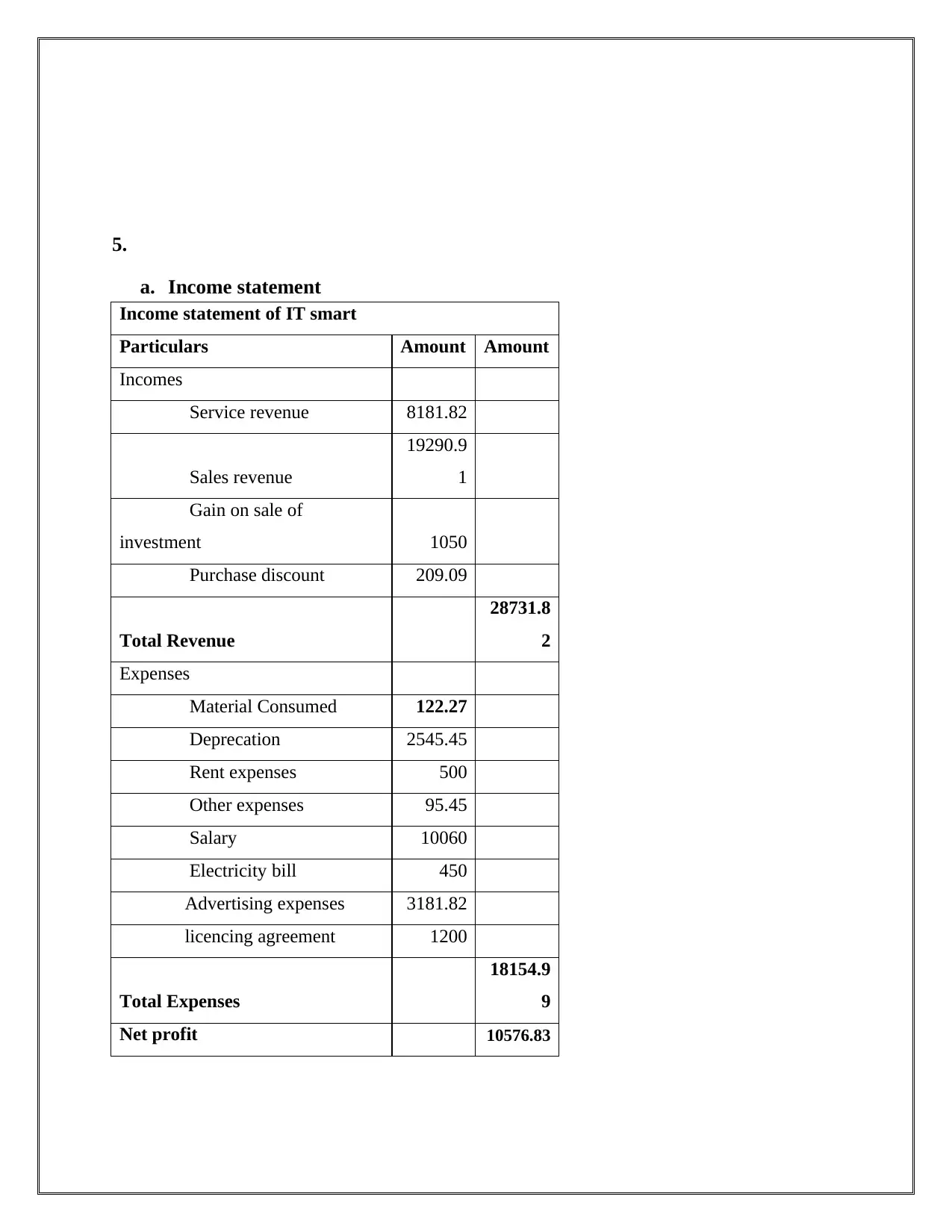
5.
a. Income statement
Income statement of IT smart
Particulars Amount Amount
Incomes
Service revenue 8181.82
Sales revenue
19290.9
1
Gain on sale of
investment 1050
Purchase discount 209.09
Total Revenue
28731.8
2
Expenses
Material Consumed 122.27
Deprecation 2545.45
Rent expenses 500
Other expenses 95.45
Salary 10060
Electricity bill 450
Advertising expenses 3181.82
licencing agreement 1200
Total Expenses
18154.9
9
Net profit 10576.83
a. Income statement
Income statement of IT smart
Particulars Amount Amount
Incomes
Service revenue 8181.82
Sales revenue
19290.9
1
Gain on sale of
investment 1050
Purchase discount 209.09
Total Revenue
28731.8
2
Expenses
Material Consumed 122.27
Deprecation 2545.45
Rent expenses 500
Other expenses 95.45
Salary 10060
Electricity bill 450
Advertising expenses 3181.82
licencing agreement 1200
Total Expenses
18154.9
9
Net profit 10576.83
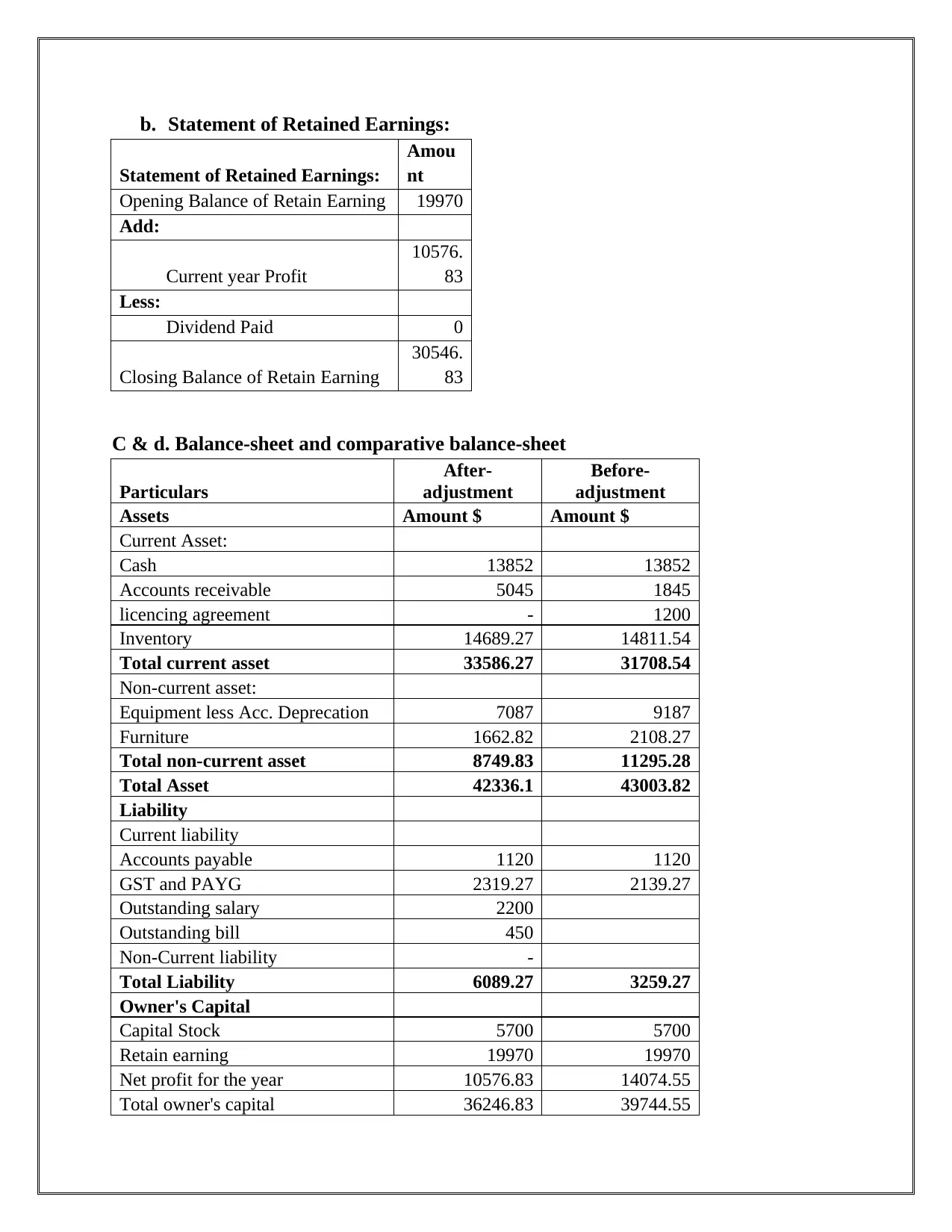
b. Statement of Retained Earnings:
Statement of Retained Earnings:
Amou
nt
Opening Balance of Retain Earning 19970
Add:
Current year Profit
10576.
83
Less:
Dividend Paid 0
Closing Balance of Retain Earning
30546.
83
C & d. Balance-sheet and comparative balance-sheet
Particulars
After-
adjustment
Before-
adjustment
Assets Amount $ Amount $
Current Asset:
Cash 13852 13852
Accounts receivable 5045 1845
licencing agreement - 1200
Inventory 14689.27 14811.54
Total current asset 33586.27 31708.54
Non-current asset:
Equipment less Acc. Deprecation 7087 9187
Furniture 1662.82 2108.27
Total non-current asset 8749.83 11295.28
Total Asset 42336.1 43003.82
Liability
Current liability
Accounts payable 1120 1120
GST and PAYG 2319.27 2139.27
Outstanding salary 2200
Outstanding bill 450
Non-Current liability -
Total Liability 6089.27 3259.27
Owner's Capital
Capital Stock 5700 5700
Retain earning 19970 19970
Net profit for the year 10576.83 14074.55
Total owner's capital 36246.83 39744.55
Statement of Retained Earnings:
Amou
nt
Opening Balance of Retain Earning 19970
Add:
Current year Profit
10576.
83
Less:
Dividend Paid 0
Closing Balance of Retain Earning
30546.
83
C & d. Balance-sheet and comparative balance-sheet
Particulars
After-
adjustment
Before-
adjustment
Assets Amount $ Amount $
Current Asset:
Cash 13852 13852
Accounts receivable 5045 1845
licencing agreement - 1200
Inventory 14689.27 14811.54
Total current asset 33586.27 31708.54
Non-current asset:
Equipment less Acc. Deprecation 7087 9187
Furniture 1662.82 2108.27
Total non-current asset 8749.83 11295.28
Total Asset 42336.1 43003.82
Liability
Current liability
Accounts payable 1120 1120
GST and PAYG 2319.27 2139.27
Outstanding salary 2200
Outstanding bill 450
Non-Current liability -
Total Liability 6089.27 3259.27
Owner's Capital
Capital Stock 5700 5700
Retain earning 19970 19970
Net profit for the year 10576.83 14074.55
Total owner's capital 36246.83 39744.55
⊘ This is a preview!⊘
Do you want full access?
Subscribe today to unlock all pages.

Trusted by 1+ million students worldwide
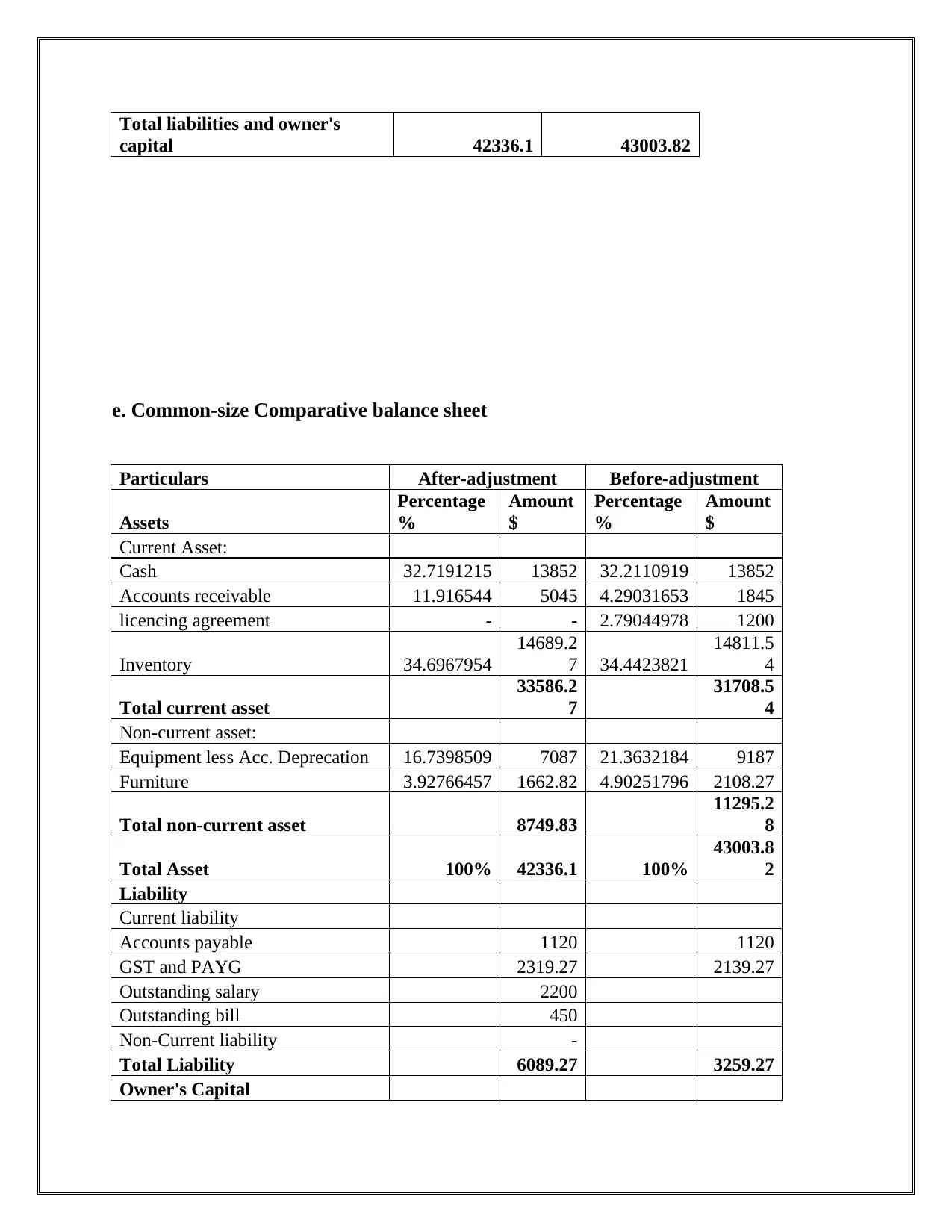
Total liabilities and owner's
capital 42336.1 43003.82
e. Common-size Comparative balance sheet
Particulars After-adjustment Before-adjustment
Assets
Percentage
%
Amount
$
Percentage
%
Amount
$
Current Asset:
Cash 32.7191215 13852 32.2110919 13852
Accounts receivable 11.916544 5045 4.29031653 1845
licencing agreement - - 2.79044978 1200
Inventory 34.6967954
14689.2
7 34.4423821
14811.5
4
Total current asset
33586.2
7
31708.5
4
Non-current asset:
Equipment less Acc. Deprecation 16.7398509 7087 21.3632184 9187
Furniture 3.92766457 1662.82 4.90251796 2108.27
Total non-current asset 8749.83
11295.2
8
Total Asset 100% 42336.1 100%
43003.8
2
Liability
Current liability
Accounts payable 1120 1120
GST and PAYG 2319.27 2139.27
Outstanding salary 2200
Outstanding bill 450
Non-Current liability -
Total Liability 6089.27 3259.27
Owner's Capital
capital 42336.1 43003.82
e. Common-size Comparative balance sheet
Particulars After-adjustment Before-adjustment
Assets
Percentage
%
Amount
$
Percentage
%
Amount
$
Current Asset:
Cash 32.7191215 13852 32.2110919 13852
Accounts receivable 11.916544 5045 4.29031653 1845
licencing agreement - - 2.79044978 1200
Inventory 34.6967954
14689.2
7 34.4423821
14811.5
4
Total current asset
33586.2
7
31708.5
4
Non-current asset:
Equipment less Acc. Deprecation 16.7398509 7087 21.3632184 9187
Furniture 3.92766457 1662.82 4.90251796 2108.27
Total non-current asset 8749.83
11295.2
8
Total Asset 100% 42336.1 100%
43003.8
2
Liability
Current liability
Accounts payable 1120 1120
GST and PAYG 2319.27 2139.27
Outstanding salary 2200
Outstanding bill 450
Non-Current liability -
Total Liability 6089.27 3259.27
Owner's Capital
Paraphrase This Document
Need a fresh take? Get an instant paraphrase of this document with our AI Paraphraser
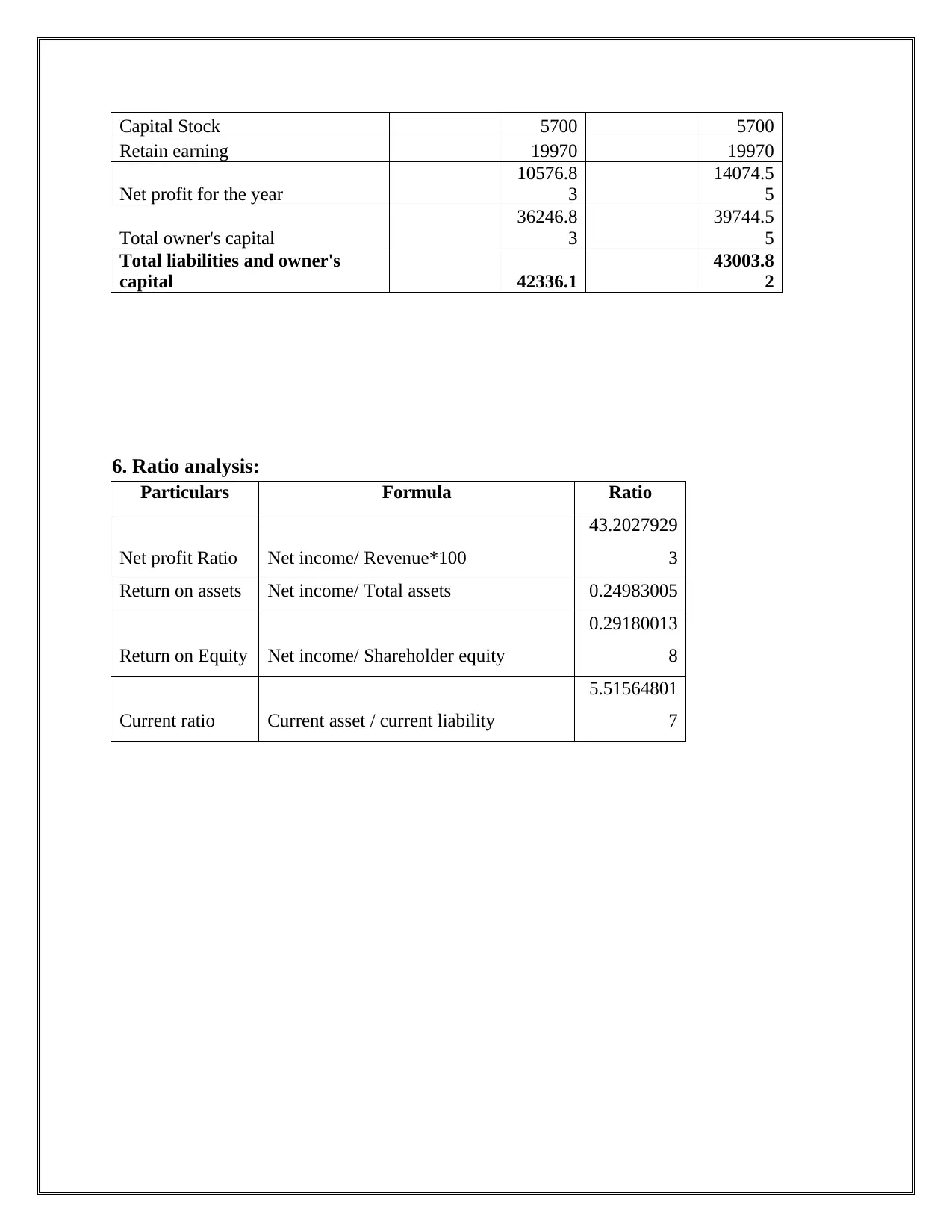
Capital Stock 5700 5700
Retain earning 19970 19970
Net profit for the year
10576.8
3
14074.5
5
Total owner's capital
36246.8
3
39744.5
5
Total liabilities and owner's
capital 42336.1
43003.8
2
6. Ratio analysis:
Particulars Formula Ratio
Net profit Ratio Net income/ Revenue*100
43.2027929
3
Return on assets Net income/ Total assets 0.24983005
Return on Equity Net income/ Shareholder equity
0.29180013
8
Current ratio Current asset / current liability
5.51564801
7
Retain earning 19970 19970
Net profit for the year
10576.8
3
14074.5
5
Total owner's capital
36246.8
3
39744.5
5
Total liabilities and owner's
capital 42336.1
43003.8
2
6. Ratio analysis:
Particulars Formula Ratio
Net profit Ratio Net income/ Revenue*100
43.2027929
3
Return on assets Net income/ Total assets 0.24983005
Return on Equity Net income/ Shareholder equity
0.29180013
8
Current ratio Current asset / current liability
5.51564801
7
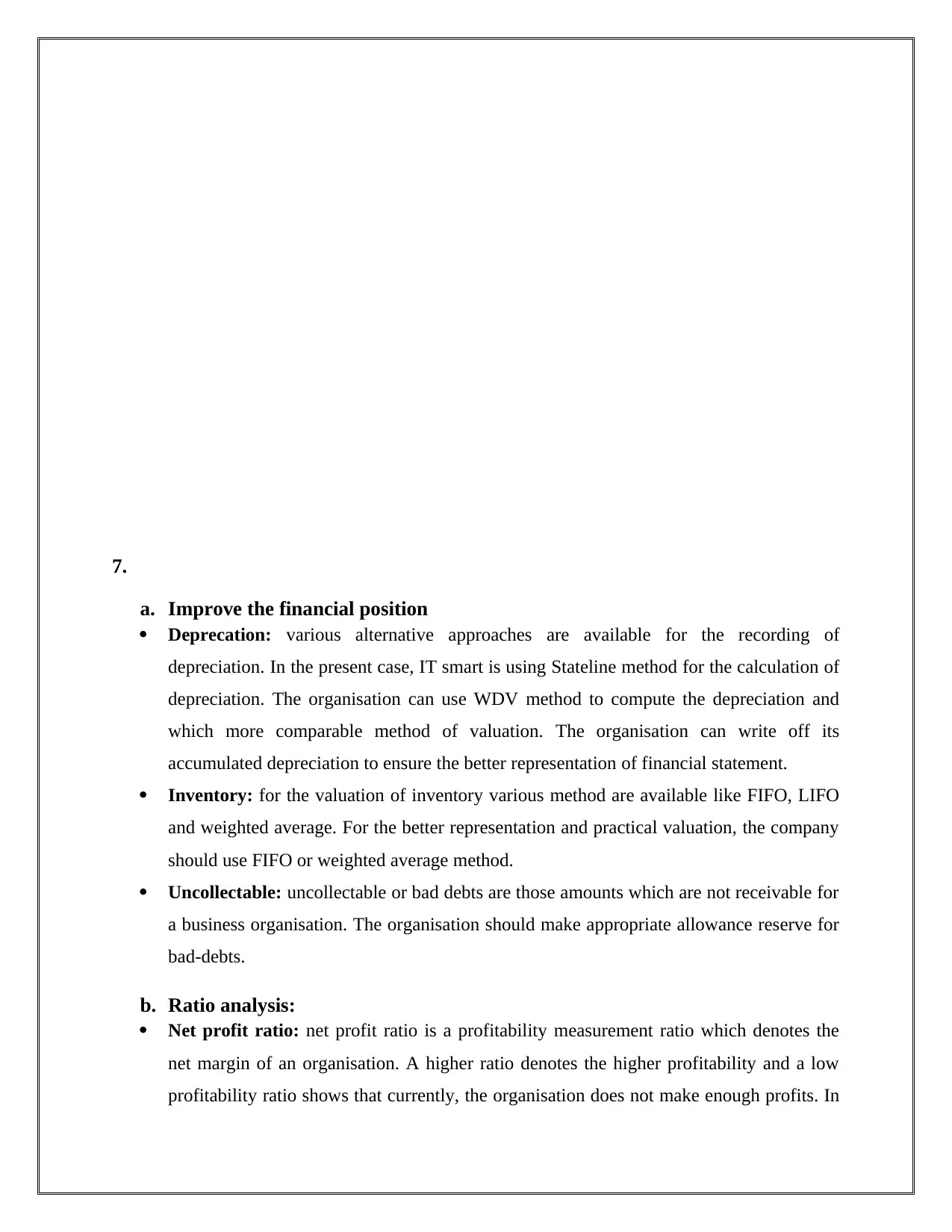
7.
a. Improve the financial position
Deprecation: various alternative approaches are available for the recording of
depreciation. In the present case, IT smart is using Stateline method for the calculation of
depreciation. The organisation can use WDV method to compute the depreciation and
which more comparable method of valuation. The organisation can write off its
accumulated depreciation to ensure the better representation of financial statement.
Inventory: for the valuation of inventory various method are available like FIFO, LIFO
and weighted average. For the better representation and practical valuation, the company
should use FIFO or weighted average method.
Uncollectable: uncollectable or bad debts are those amounts which are not receivable for
a business organisation. The organisation should make appropriate allowance reserve for
bad-debts.
b. Ratio analysis:
Net profit ratio: net profit ratio is a profitability measurement ratio which denotes the
net margin of an organisation. A higher ratio denotes the higher profitability and a low
profitability ratio shows that currently, the organisation does not make enough profits. In
a. Improve the financial position
Deprecation: various alternative approaches are available for the recording of
depreciation. In the present case, IT smart is using Stateline method for the calculation of
depreciation. The organisation can use WDV method to compute the depreciation and
which more comparable method of valuation. The organisation can write off its
accumulated depreciation to ensure the better representation of financial statement.
Inventory: for the valuation of inventory various method are available like FIFO, LIFO
and weighted average. For the better representation and practical valuation, the company
should use FIFO or weighted average method.
Uncollectable: uncollectable or bad debts are those amounts which are not receivable for
a business organisation. The organisation should make appropriate allowance reserve for
bad-debts.
b. Ratio analysis:
Net profit ratio: net profit ratio is a profitability measurement ratio which denotes the
net margin of an organisation. A higher ratio denotes the higher profitability and a low
profitability ratio shows that currently, the organisation does not make enough profits. In
⊘ This is a preview!⊘
Do you want full access?
Subscribe today to unlock all pages.

Trusted by 1+ million students worldwide
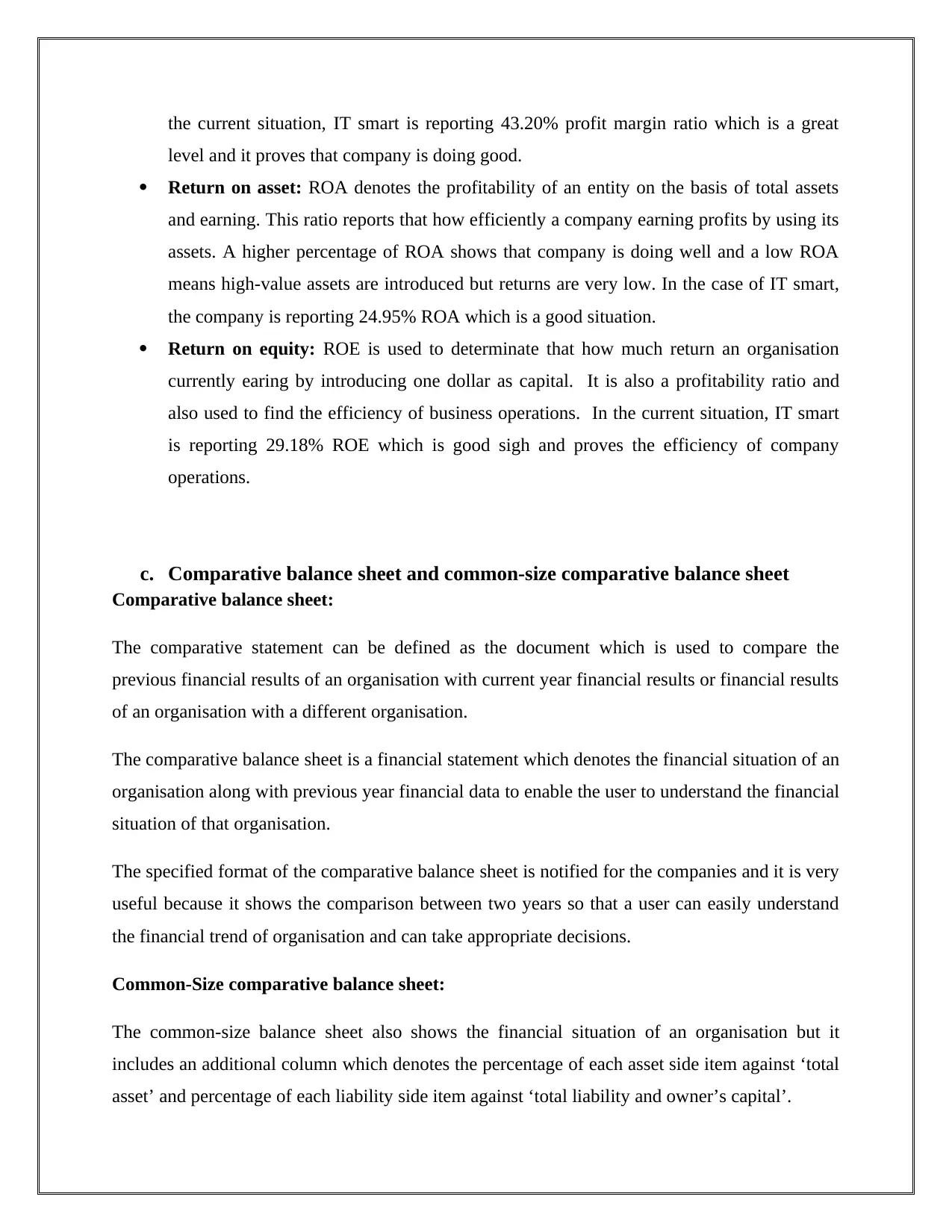
the current situation, IT smart is reporting 43.20% profit margin ratio which is a great
level and it proves that company is doing good.
Return on asset: ROA denotes the profitability of an entity on the basis of total assets
and earning. This ratio reports that how efficiently a company earning profits by using its
assets. A higher percentage of ROA shows that company is doing well and a low ROA
means high-value assets are introduced but returns are very low. In the case of IT smart,
the company is reporting 24.95% ROA which is a good situation.
Return on equity: ROE is used to determinate that how much return an organisation
currently earing by introducing one dollar as capital. It is also a profitability ratio and
also used to find the efficiency of business operations. In the current situation, IT smart
is reporting 29.18% ROE which is good sigh and proves the efficiency of company
operations.
c. Comparative balance sheet and common-size comparative balance sheet
Comparative balance sheet:
The comparative statement can be defined as the document which is used to compare the
previous financial results of an organisation with current year financial results or financial results
of an organisation with a different organisation.
The comparative balance sheet is a financial statement which denotes the financial situation of an
organisation along with previous year financial data to enable the user to understand the financial
situation of that organisation.
The specified format of the comparative balance sheet is notified for the companies and it is very
useful because it shows the comparison between two years so that a user can easily understand
the financial trend of organisation and can take appropriate decisions.
Common-Size comparative balance sheet:
The common-size balance sheet also shows the financial situation of an organisation but it
includes an additional column which denotes the percentage of each asset side item against ‘total
asset’ and percentage of each liability side item against ‘total liability and owner’s capital’.
level and it proves that company is doing good.
Return on asset: ROA denotes the profitability of an entity on the basis of total assets
and earning. This ratio reports that how efficiently a company earning profits by using its
assets. A higher percentage of ROA shows that company is doing well and a low ROA
means high-value assets are introduced but returns are very low. In the case of IT smart,
the company is reporting 24.95% ROA which is a good situation.
Return on equity: ROE is used to determinate that how much return an organisation
currently earing by introducing one dollar as capital. It is also a profitability ratio and
also used to find the efficiency of business operations. In the current situation, IT smart
is reporting 29.18% ROE which is good sigh and proves the efficiency of company
operations.
c. Comparative balance sheet and common-size comparative balance sheet
Comparative balance sheet:
The comparative statement can be defined as the document which is used to compare the
previous financial results of an organisation with current year financial results or financial results
of an organisation with a different organisation.
The comparative balance sheet is a financial statement which denotes the financial situation of an
organisation along with previous year financial data to enable the user to understand the financial
situation of that organisation.
The specified format of the comparative balance sheet is notified for the companies and it is very
useful because it shows the comparison between two years so that a user can easily understand
the financial trend of organisation and can take appropriate decisions.
Common-Size comparative balance sheet:
The common-size balance sheet also shows the financial situation of an organisation but it
includes an additional column which denotes the percentage of each asset side item against ‘total
asset’ and percentage of each liability side item against ‘total liability and owner’s capital’.
Paraphrase This Document
Need a fresh take? Get an instant paraphrase of this document with our AI Paraphraser
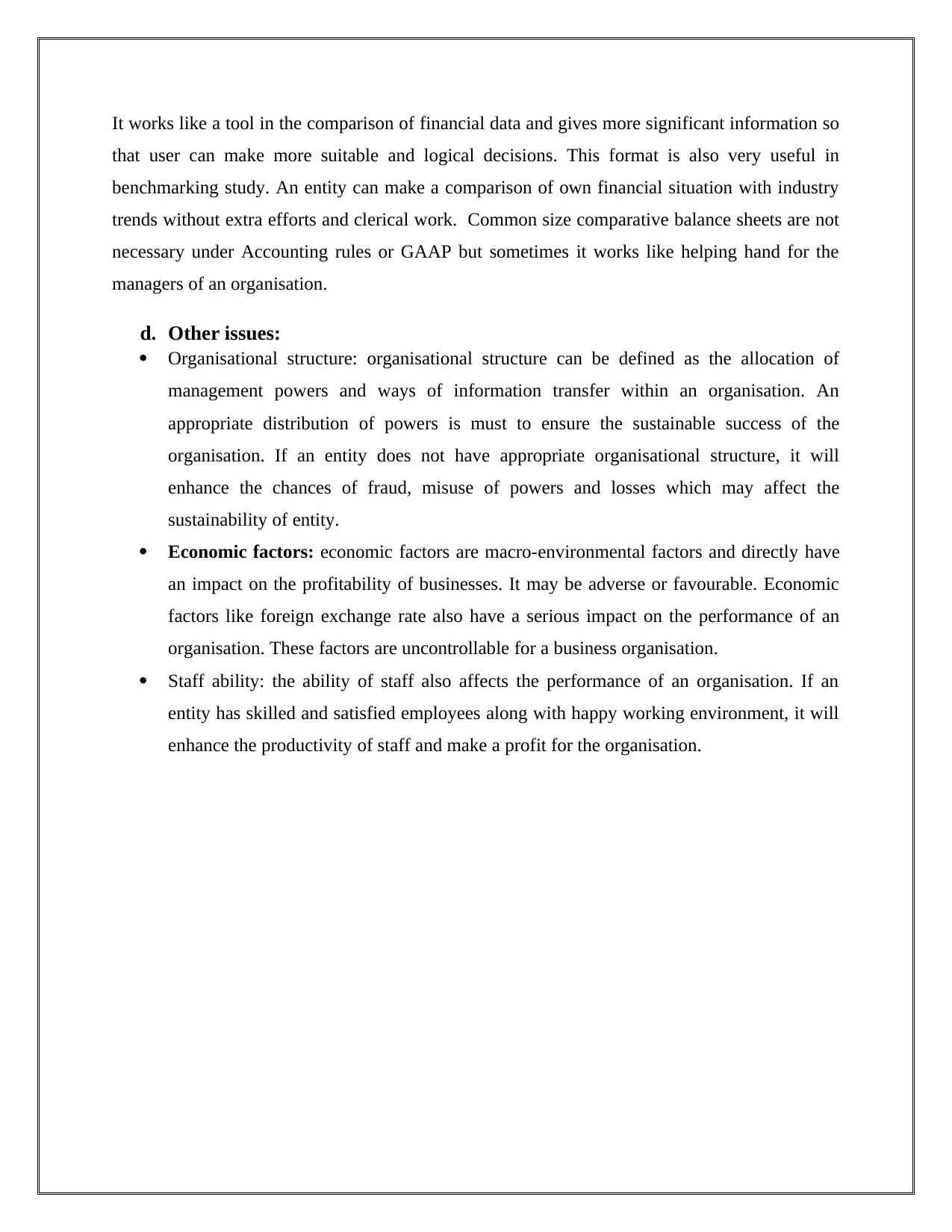
It works like a tool in the comparison of financial data and gives more significant information so
that user can make more suitable and logical decisions. This format is also very useful in
benchmarking study. An entity can make a comparison of own financial situation with industry
trends without extra efforts and clerical work. Common size comparative balance sheets are not
necessary under Accounting rules or GAAP but sometimes it works like helping hand for the
managers of an organisation.
d. Other issues:
Organisational structure: organisational structure can be defined as the allocation of
management powers and ways of information transfer within an organisation. An
appropriate distribution of powers is must to ensure the sustainable success of the
organisation. If an entity does not have appropriate organisational structure, it will
enhance the chances of fraud, misuse of powers and losses which may affect the
sustainability of entity.
Economic factors: economic factors are macro-environmental factors and directly have
an impact on the profitability of businesses. It may be adverse or favourable. Economic
factors like foreign exchange rate also have a serious impact on the performance of an
organisation. These factors are uncontrollable for a business organisation.
Staff ability: the ability of staff also affects the performance of an organisation. If an
entity has skilled and satisfied employees along with happy working environment, it will
enhance the productivity of staff and make a profit for the organisation.
that user can make more suitable and logical decisions. This format is also very useful in
benchmarking study. An entity can make a comparison of own financial situation with industry
trends without extra efforts and clerical work. Common size comparative balance sheets are not
necessary under Accounting rules or GAAP but sometimes it works like helping hand for the
managers of an organisation.
d. Other issues:
Organisational structure: organisational structure can be defined as the allocation of
management powers and ways of information transfer within an organisation. An
appropriate distribution of powers is must to ensure the sustainable success of the
organisation. If an entity does not have appropriate organisational structure, it will
enhance the chances of fraud, misuse of powers and losses which may affect the
sustainability of entity.
Economic factors: economic factors are macro-environmental factors and directly have
an impact on the profitability of businesses. It may be adverse or favourable. Economic
factors like foreign exchange rate also have a serious impact on the performance of an
organisation. These factors are uncontrollable for a business organisation.
Staff ability: the ability of staff also affects the performance of an organisation. If an
entity has skilled and satisfied employees along with happy working environment, it will
enhance the productivity of staff and make a profit for the organisation.
1 out of 11
Related Documents
Your All-in-One AI-Powered Toolkit for Academic Success.
+13062052269
info@desklib.com
Available 24*7 on WhatsApp / Email
![[object Object]](/_next/static/media/star-bottom.7253800d.svg)
Unlock your academic potential
Copyright © 2020–2025 A2Z Services. All Rights Reserved. Developed and managed by ZUCOL.





